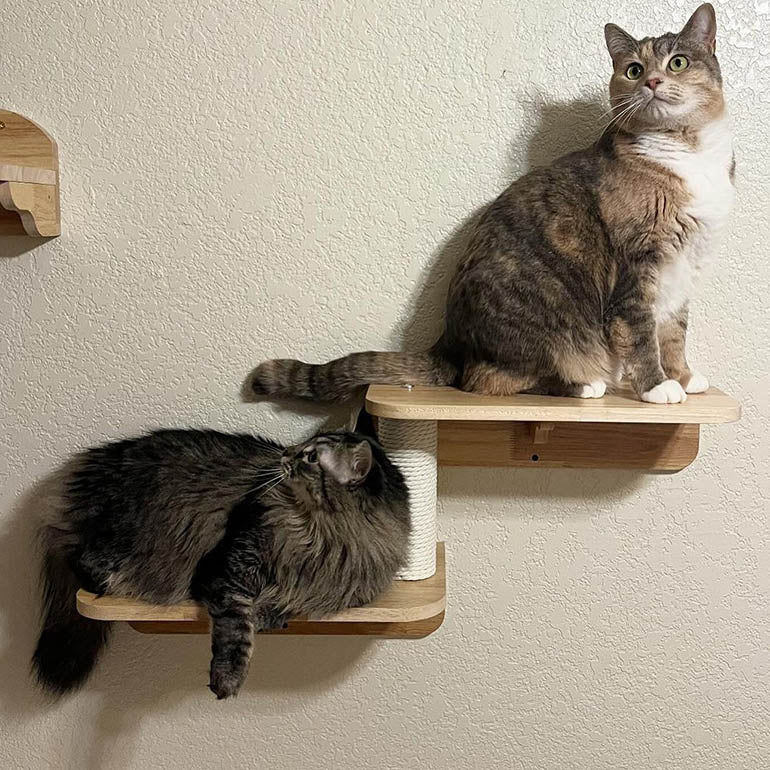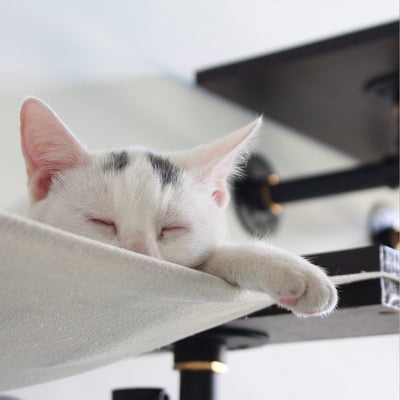Installing a wall-mounted cat shelf can provide great enjoyment for your feline friend. However, since these shelves are overhead structures, proper installation and mounting are crucial to avoid safety hazards. Be sure to make cat-shelf security a top priority during setup.
Here are tips for safely installing, inspecting, and using your wall-mounted cat furniture.

Select a Sturdy Shelf
Your choice of cat shelf itself is the first factor in safety. Carefully inspect the product specifications before purchasing.
Construction Quality
- Solid wood or metal frames are best
- Avoid flimsy thin plastic or cardboard
- Reinforced edges and joints add strength
- No signs of damage out of the box
- Durable carpeting or sisal rope surfaces
The shelf should feel substantial and stable in your hands before mounting. Tap along edges to check for hollow sounds indicating poor fabrication.
Weight Capacity
- Hold the weight of the largest cat with room to spare
- Shelves should support 30+ pounds
- Multi-cat shelves need higher capacity
- Check for specific manufacturer limits
Look for quality hardware like steel brackets and bolts. Plastic components are weaker. Inspect welding on metal frames.
Mounting Hardware
- Includes robust brackets and fittings
- Wall anchors included if needed
- All parts are made of durable materials
- Provides enough mounting points
- A complete mounting kit is ideal
Sheet metal brackets tend to be more sturdy than plastic versions. The included hardware should match the recommended installation steps.
Stable Design
- Low center of gravity
- No easily tipped components
- Wide, non-slip surfaces
- Side rails prevent falling
- Angled legs or platform for stability
Avoid ornate or top-heavy shelf designs that seem precarious. Flat and firmly grounded is best for safety.
Reviews
- Check for positive feedback on safety and security
- Look for concerning comments about quality
- Is the company responsive to issues?
Research thoroughly before selecting a shelf model. Checking reviews can reveal potential weaknesses to avoid.

Gather Proper Tools
Along with a quality cat shelf, having the right tools is essential for proper installation.
- Tape measure and pencil
- Stud finder for locating studs
- Level to check the plane
- Electric drill and bits
- Drywall anchors if needed
- Wrench and screwdriver set
Make sure you have all the necessary drill and driver bits. Fully charge power tools beforehand. Inspect and test tools to verify in working order. Having proper tools prevents safety risks from increasing. (PETOMG offers two wall anchor kits based on solid wall and drywall, as well as screwdrivers to meet your installation needs.)
Create an Installation Plan
- Carefully plan out your entire process before starting.
- Decide on the optimal shelf location
- Mark where studs are located
- Map out the placement of hardware
- Note any potential issues or obstacles
- List all required tools and hardware
- Review manufacturer instructions multiple times
Take measurements and sketch your plans if helpful. Having a clear written plan prevents forgetting steps or making poor in-the-moment decisions.
Pick a Safe Mounting Location
The placement of your cat’s shelf is another key safety factor during installation.
- Avoid above fragile objects or electronics
- Ensure adequate clearance for use and jumping
Check the area above and below the shelf location. Make sure no risks like radiators or other furniture are underneath. There should be open floor space for your cat to utilize the shelf safely.
Inspect Wall Integrity
Prior to installation, carefully inspect the condition of the wall itself:
- Check for small cracks or holes in the drywall
- Tap along the wall for hidden spaces or damage
- Verify the wall is dry with no leaks or moisture
- No exposed wires or other hazards
- Remove any protruding nails or hooks
- Look for covered vents or ductwork
Repair any wall damage like large gouges that reduce integrity. The surface needs to be sound enough for secure hardware installation.
Safety Gear
Use appropriate safety gear during installation.
- Protective eyewear when drilling
- Dust mask if sanding or spackling
- Ear protection from power tools
- Rubber gloves for grip if needed
- Hard hat if drilling overhead
- Bright workshop lighting
Take precautions against dust, debris, and power tool noise. Proper gear enhances safety for you and allows accident-free installation.
Follow Install Directions
Referring to the shelf’s instructions, properly install using all provided hardware and steps.
- Use a stud finder to mark stud locations
- Drill pilot holes at markings
- Use wall anchors and screws in drywall
- Tighten all hardware securely
- Check for level and plumb alignment
- Test stability before cat accesses
Perform a dry run of the installation without fully tightening the hardware. Make sure the shelf fits and connections align before permanent mounting.
Double Up Mounting Points
For larger or multi-cat shelves, consider adding supplemental mounting points by:
- Using extra wall anchors in drywall sections
- Attaching additional L-brackets at the ends
- Securing ceiling joists above if possible
- Anchoring to floor molding below
- Bolting related cat furniture together
Spreading out the mounting hardware over more points distributes weight better. Align symmetrical weight distribution if possible.
Check All Hardware Regularly
After installation, check the tightened hardware weekly first then monthly.
- Jiggle shelf and brackets to test
- Examine for any loosening over time
- Look for signs of bending or damage
- Tighten any loose screws immediately
- Add shelf support if needed long-term
Don’t allow small issues to become dangerous. Regularly verifying security should be part of lifelong cat-shelf maintenance.
Use Safety Accessories
Additional cat shelf safety accessories can provide protection:
- L-brackets for added support
- Shelf rails prevent falling
- Sisal scratch pads minimize damage
- Cushions below absorb the impact
- Safety straps anchor to wall stud
- Plexiglass sides for rowdy cats
- Place food dishes to prevent tipping
Rotate toys attached with string to maintain sturdiness. Cover ramps with grip tape if slippery. Use good judgment with accessories.

Limit Cat Chaos
The way your cat uses the shelf also affects ongoing safety.
- Discourage aggressive play or roughhousing
- Try to minimize chasing or pouncing
- Add sloped ramps for easier access
- Keep extra weight like cat beds light
- Remove temptingly dangling strings or toys
- Prevent overcrowding if a multi-cat shelf
Provide alternative outlets like scratching posts for energetic play. Restrict access if misuse, territorial fights or toddler tampering becomes an issue.
Watch for Damage
With regular use, wear and tear can occur. Look for:
- Splintering or gouges in wood
- Fraying fabric or carpet
- Rusting metal components
- Wall cracks around hardware
- Shelf sagging in one corner
In addition to visual inspection, run your hand along the entire shelf monthly feeling for flaws. Address any concerns immediately for safety.
Allow Proper Use Time
After initial installation, give your cat time to become accustomed to the shelf safely.
- Keep the shelf close to the ground at first
- Slowly increase height over weeks
- Monitor cat accessing shelf
- Look for fearful or clumsy actions
- Remove if the cat seems distressed
Some cats may be naturally hesitant to utilize a wall-mounted space. Have patience and let them build confidence before elevating the shelf.
Practice Regular Maintenance
Ongoing maintenance helps preserve safety.
- Keep shelves and accessories clean
- Vacuum or wipe down weekly
- Check and tighten mounting points
- Replace worn parts as needed
- Test stability after cleaning or changes
Develop a habitual maintenance routine. Mark your calendar for reminders if needed. Upkeep prevents deterioration.
Know Your Cat’s Limits
Be realistic about your cat’s abilities and limitations to use good judgment.
- Can large or overweight cats fit and move around?
- Are jumps up/down too far for their mobility?
- Is your senior cat steady on their feet?
- Does the cat have vision or depth issues?
Think twice before mounting shelves high or using multi-tier styles for elderly, disabled or very young cats. Choose smart accessories that support their needs.
Conclusion
While following common sense precautions may seem tedious, ensuring your cat’s safety is the top priority. Take time to properly assess the installation site, select a sturdy shelf and hardware, mount securely, and monitor use over time.
Giving your cat great vertical space enhances their life, but only when done safely. With prudent preparation and vigilance, your cherished cat can enjoy their wall-mounted shelf for years to come.


